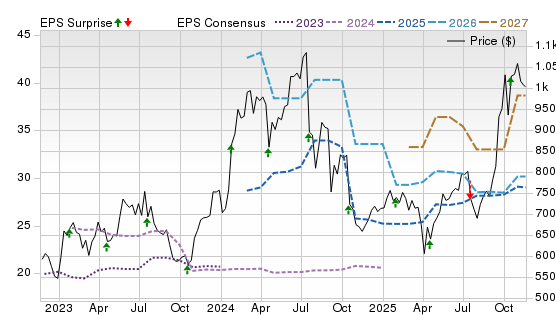5 Best Quantum Computing Stocks to Buy Today
| Company (Ticker) | 12 Week Price Change | Forward PE | Price | Proj EPS Growth (1 Year) | Projected Sales Growth (1Y) |
|---|---|---|---|---|---|
| Micron Technology (MU) | 65.06% | 11.99 | $207.37 | 102.56% | 45.76% |
| Teradyne (TER) | 32.24% | 44.43 | $158.91 | 8.97% | 8.06% |
| Lam Research (LRCX) | 34.10% | 29.16 | $142.65 | 15.64% | 14.06% |
| ASML Holding (ASML) | 28.50% | 33.82 | $966.57 | 39.31% | 23.21% |
| COHERENT CORP (COHR) | 42.45% | 26.99 | $139.51 | 42.32% | 15.16% |
*Updated on November 21, 2025.
Micron Technology (MU)
$207.37 USD +6.00 (2.98%)
3-Year Stock Price Performance

Premium Research for MU
- Zacks Rank
- Strong Buy 1
- Style Scores
B Value A Growth A Momentum A VGM
- Market Cap:$256.86B (Large Cap)
- Projected EPS Growth:102.53%
- Last Quarter EPS Growth:65.32%
- Last EPS Surprise5.94%
- Next EPS Report date: Dec. 17, 2025
Our Take:
Micron makes DRAM, NAND, and high-bandwidth memory that power data centers and AI accelerators. The company’s advanced memory and HBM3E are relevant for quantum and hybrid systems where speed and thermal efficiency matter. The company’s R&D and industry collaborations around high-performance computing position its memory and packaging know-how for workloads that bridge classical and quantum pipelines.
Its Zacks Rank of 1 (Strong Buy) reflects positive estimate revisions, in line with a strengthening memory upcycle. The Style Score of A for Growth signals earnings rebound, while the scores of C for Value and D for Momentum indicate the shares are not cheap and may trade unevenly as supply catches up.
On the Price, Consensus & EPS Surprise chart, the stock’s uptrend coincides with rising 2026 and 2027 EPS lines and a turn higher in 2025, a constructive pattern that supports the Rank and is consistent with a strengthening memory upcycle and better visibility into out-year profitability.
Teradyne (TER)
$158.91 USD +3.01 (1.93%)
3-Year Stock Price Performance

Premium Research for TER
- Zacks Rank
 Buy 2
Buy 2
- Style Scores
D Value F Growth B Momentum F VGM
- Market Cap: $27.76B (Large Cap)
- Projected EPS Growth:7.45%
- Last Quarter EPS Growth:49.12%
- Last EPS Surprise: 8.97%
- Next EPS Report date: Feb 4, 2026
Our Take:
Teradyne supplies automated test equipment (ATE) used to validate complex chips across logic, RF, and photonics. The company acquired Quantifi Photonics, adding turnkey photonic integrated circuit test solutions that support silicon photonics and optical interconnects, key building blocks for quantum and high-performance systems that mix electronics and light. Management has highlighted how ATE must evolve with chip complexity, which keeps Teradyne close to leading-edge customers.
A Zacks Rank #1 reflects improving revisions. The Style Scores of F for Value and Growth caution that expectations are elevated, while a score of B for Momentum points to constructive price action.
On the chart, price momentum has accelerated while the 2026 and 2027 EPS estimate lines inflect higher after a trough, a setup that favors further estimate revision if photonics and AI test orders sustain.
Lam Research (LRCX)
$142.65 USD +3.06 (2.19%)
3-Year Stock Price Performance

Premium Research for LRCX
- Zacks Rank
 Buy 2
Buy 2
- Style Scores
D Value A Growth C Momentum B VGM
- Market Cap: $179.91B (Large Cap)
- Projected EPS Growth:15.70%
- Last Quarter EPS Growth: -5.26%
- Last EPS Surprise: 4.13%
- Next EPS Report date:Feb. 4, 2026
Our Take:
Lam Research provides etch and deposition systems that shape transistors and materials at the atomic scale, tools also used in academic and industrial labs building quantum devices and cryogenic electronics. This year, Lam donated a leading-edge etch platform to accelerate research that includes quantum hardware, while advances in ALE and ALD processing are being explored to reduce loss in superconducting qubits. These capabilities tie Lam to both AI and quantum fabrication roadmaps.
The Zacks Rank #2 (Buy) alongside a Style Score of A for Growth and B for Momentum fits a story of rising earnings power, but a score of D for Value implies limited multiple support.
The chart shows a firm uptrend in out-year EPS estimates and shares pushing to highs, consistent with stronger WFE spending and confidence in Lam’s positioning across classical and quantum-enabling processes.
ASML Holding (ASML)
$966.57 USD -14.47 (-1.47%)
3-Year Stock Price Performance

Premium Research for ASML
- Zacks Rank
 Buy 2
Buy 2
- Style Scores
F Value F Growth D Momentum F VGM
- Market Cap:$394.88B (Large Cap)
- Projected EPS Growth: 39.29%
- Last Quarter EPS Growth:40.88%
- Last EPS Surprise:2.23%
- Next EPS Report date: Feb. 4, 2026
Our Take:
ASML is the sole supplier of extreme ultraviolet lithography systems that enable the world’s most advanced chips, with High NA EUV now shipping and being installed for early development and prototyping. As nodes shrink, EUV is indispensable for control ICs, cryo electronics, and photonic devices used alongside quantum systems, keeping ASML central to any roadmap that requires density and precision. Management targets stronger EUV revenue as High NA adoption widens.
A Zacks Rank of 2 reflects solid, though not peak, estimate momentum. Style Scores of F for Value and Growth and a D for Momentum highlight expensive shares that can swing with order timing.
The chart shows a choppy price path but a notable upturn in 2027 EPS expectations and stabilization in 2025 to 2026, consistent with a multiyear EUV cycle as High NA moves from trials to broader use.
COHERENT CORP (COHR)
$139.51 USD +3.90 (2.88%)
3-Year Stock Price Performance

Premium Research for COHR
- Zacks Rank
 Buy 2
Buy 2
- Style Scores
C Value C Growth B Momentum B VGM
- Market Cap:$21.71B (Large Cap)
- Projected EPS Growth:42.21%
- Last Quarter EPS Growth: 25.68%
- Last EPS Surprise:11.54%
- Next EPS Report date:Feb. 4, 2026
Our Take:
Coherent builds the lasers, optics, and photonics used to manipulate, cool, and measure atoms, ions, and photons, which are core building blocks of quantum computers and quantum networking. Its portfolio includes narrow-linewidth and pulsed lasers used in cold-atom and quantum-optics experiments, and the company notes deployments in emerging room-temperature photonic platforms. The portfolio positions the company to supply components across quantum computing, sensing, and communications while also leveraging demand from the AI era optical networks.
A Zacks Rank of 2 with a Momentum score of A suggests improving estimate revisions and sentiment, while C scores for both Value and Growth indicate progress but not a deep bargain.
On the chart, the stock has broken out with 2026 and 2027 EPS estimates turning sharply higher after a long reset, an encouraging sign that mix and pricing in photonics and precision lasers are feeding through to earnings expectations.
Methodology
The Zacks Rank is a proprietary stock-rating model that uses trends in earnings estimate revisions and earnings-per-share (EPS) surprises to classify stocks into five groups: #1 (Strong Buy), #2 (Buy), #3 (Hold), #4 (Sell) and #5 (Strong Sell). The Zacks Rank is calculated through four primary factors related to earnings estimates: analysts' consensus on earnings estimate revisions, the magnitude of revision change, the upside potential and estimate surprise (or the degree in which earnings per share deviated from the previous quarter).
Zacks builds the data from 3,000 analysts at over 150 different brokerage firms. The average yearly gain for Zacks Rank #1 (Strong Buy) stocks is +23.62% per year from January, 1988, through June 2, 2025.
Selections for Best Quantum Computing Stocks are based on the current top ranking stocks based on Zacks Indicator Score. For this list, only companies that have average daily trading volumes of 100,000 shares or more and at least five analysts covering the stock were considered. All information is current as of market open, Nov. 19, 2025.
Introduction to Quantum Computing Stocks
What Are Quantum Computing Stocks?
Quantum computing stocks are publicly traded companies that develop quantum hardware, quantum software, or platforms that allow customers to access quantum systems. These firms range from early-stage, pure-play quantum companies to tech giants that treat quantum computing as part of a broader innovation portfolio.
Quantum computing companies fall into several distinct categories. Understanding these groups—and which stocks belong to each—helps investors target the level of risk and exposure they want.
1. Pure-Play Quantum Hardware Companies
These companies focus almost entirely on building quantum computers and related systems. They generate most of their revenue from quantum technology rather than broader tech operations.
Examples:
- IonQ (IONQ) – Specializes in trapped-ion quantum computers with cloud access via AWS, Azure, and Google Cloud.
- Rigetti Computing (RGTI) – Builds superconducting quantum processors and hybrid quantum–classical platforms.
- D-Wave Quantum (QBTS) – Develops quantum annealing systems optimized for real-time optimization tasks.
These companies offer the highest direct exposure to quantum technology, but also carry the most risk and volatility.
2. Quantum Software & Algorithm Developers
These firms build software tools, algorithms, and operating environments that run on quantum hardware, often partnering with multiple hardware providers.
Examples:
- Quantum Computing Inc. (QUBT) – Develops photonic-based systems and reservoir computing models along with software tools for quantum applications.
- Horizon Quantum Computing (Private) – Works on compiling classical code into quantum-ready programs.
- Zapata AI (Private, formerly Zapata Computing) – Focuses on quantum-inspired optimization and machine-learning software.
Though many quantum software leaders are still private, companies like QUBT give public investors access to this segment.
3. Hybrid or Quantum-Adjacent Computing Companies
These firms don’t build full quantum computers but develop technologies that support or complement quantum computing, such as photonics, cryogenics, advanced sensors, or quantum communication systems.
Examples:
- Nvidia (NVDA) – Provides GPU platforms that power quantum simulations and hybrid quantum–classical workflows.
- Adtran (ADTN) – Develops quantum-safe networking solutions.
- Hamamatsu Photonics (HPHTF) – Manufactures detectors and lasers used in quantum research.
- Arqit Quantum (ARQQ) – Specializes in quantum encryption and quantum-safe security.
These stocks offer exposure to the broader quantum ecosystem with lower technological risk.
4. Large-Cap Technology Companies With Quantum Divisions
These tech giants invest heavily in quantum computing R&D as part of their broader innovation strategy. Their quantum operations are small relative to total revenue, but their resources make them long-term contenders.
Examples:
- Alphabet (GOOGL) – Google Quantum AI leads in superconducting qubit research and error correction breakthroughs.
- IBM (IBM) – Operates one of the world’s largest quantum ecosystems with IBM Quantum and a multi-year quantum development roadmap.
- Microsoft (MSFT) – Develops topological qubits and runs the Azure Quantum cloud platform.
- Amazon (AMZN) – Provides quantum access through AWS Braket and invests in multiple quantum hardware startups.
These companies offer the safest quantum exposure because their success does not depend solely on quantum breakthroughs.
Practical Use Cases and Near-Future Applications
Quantum computing is expected to disrupt industries that depend on immense computational power. While fully fault-tolerant systems may still be years away, several near-term applications are starting to emerge:
- Optimization problems (logistics, supply chain, routing).
- Drug discovery & materials science.
- Financial modeling, risk analysis & portfolio optimization.
- AI acceleration via quantum-enhanced machine learning.
- Cybersecurity & post-quantum cryptography.
Hybrid quantum-classical systems — already accessible via cloud platforms — are likely to be the earliest source of commercial value.
Is It Too Early to Invest in Quantum Computing Stocks Now?
Quantum computing is still in its infancy. For many investors, this raises a fair question: Is now the right time—or too soon—to buy quantum stocks?
Why It Might Be Too Early
- Many quantum companies are unprofitable and years from commercial-scale revenue.
- Stock prices tend to swing sharply on small news events.
- Quantum hardware still faces challenges like error correction and qubit stability.
Why Some Investors Are Buying Now
- Governments and corporations are investing heavily, accelerating progress.
- Several quantum companies now have real customers and recurring revenue.
- Major breakthroughs could significantly revalue early-stage players.
- Wall Street analysts are increasingly bullish on select names.
Bottom line: Quantum stocks are a high-risk, long-term bet — similar to early semiconductor or AI companies decades ago. Investors with patience and risk tolerance may see significant upside.
Pros and Cons of Investing in Quantum Computing Stocks
Benefits of Buying Quantum Computing Stocks
- Potential for exponential long-term returns
- Exposure to a transformative next-generation technology
- Early participation in a market that could rival today’s semiconductor or AI industries
- Increasing institutional interest and government funding
Risks of Buying Quantum Computing Stocks
- Many companies have uncertain business models
- High volatility and frequent price spikes/drops
- Long timelines for commercial viability
- Unproven technologies may never reach scale
- Cash burn and capital-raising risks
Are Quantum Computing Stocks a Good Long-Term Investment?
Quantum stocks can be an excellent long-term play if you:
- Can tolerate long periods of volatility
- Want exposure to frontier technologies
- Have a multi-year investment horizon
- Understand that profitability may be far off
For conservative investors, a diversified tech name like Alphabet offers safer quantum exposure.
Investing in Quantum Computing Stocks
How Do You Invest in Quantum Computing Stocks?
- Buy shares directly through a brokerage.
- Use thematic ETFs with exposure to quantum and advanced computing.
- Consider fractional shares to reduce risk in volatile names.
How to Select the Best Quantum Computing Stocks
Look for:
- Technological roadmaps — Qubit count, error rates, scalability.
- Commercial traction — Customers, recurring revenue, cloud deployments.
- Strong partnerships — Government, enterprise, and strategic alliances.
- Financial health — Cash reserves and sustainable burn rates.
- Analyst ratings and price targets — Look at what analysts covering the stock say and prediction for future share prices.
Market Timing and Future Outlook
When Will Quantum Computing Be Commercially Viable?
Most experts predict:
- Early commercial applications: Within 2–5 years.
- Broader enterprise deployment: Within 5–10 years.
- Fully fault-tolerant quantum systems: Likely 10+ years away.
Progress is accelerating, but meaningful revenue at industrial scale may take time.
Key Technological Breakthroughs to Watch
- Improvements in quantum error correction.
- Advances in qubit stability and coherence.
- Achieving quantum advantage in real-world tasks.
- Expansion of quantum cloud services.
- Launch of commercial-grade next-generation quantum processors.
- Cross-industry partnerships in AI, pharmaceuticals, and logistics.














